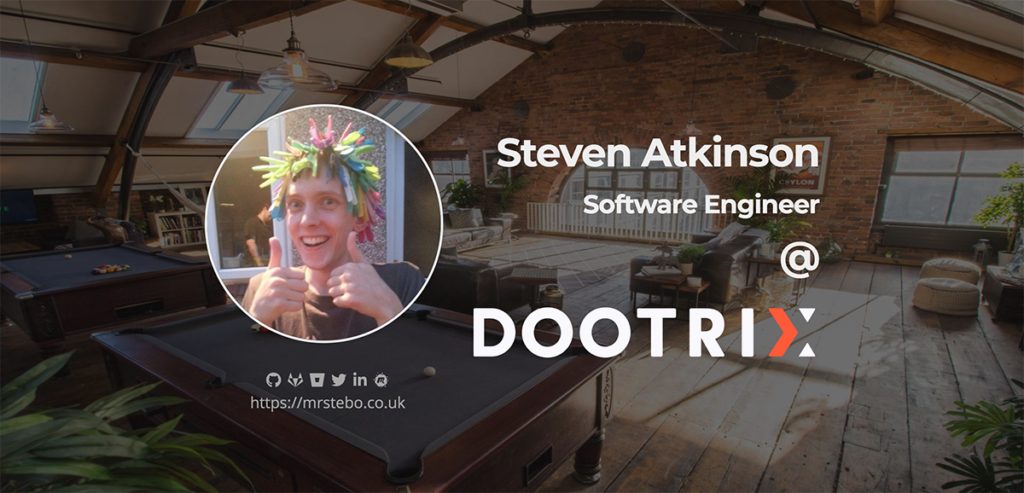Part of my new year's resolution was to start contributing more to the tech community around Manchester. I regularly attend meetups and have found myself coming away feeling enlightened and with some great ideas to share with my work colleagues.
The main focal point of my plan was to focus on public speaking. At these meetups, you can volunteer to do a talk about an area of tech that you find interesting. For me, that scope is quite sizeable, as I am constantly adapting and researching tools to get a broader insight into design decisions and why those decisions were made.
Since the start of the year, I’ve already spoken at two meetups. Those were Manchester Web and DotNetNorth. I have also done a few presentations at Dootrix on a variety of subjects.
What is the experience like?
It is pretty nerve-wracking. Public speaking is one of the aspects of my life that takes me on an adventure outside of my comfort zone, and I can imagine that is the same story for quite a lot of people. There is always a sense of anxiety, and you worry about being judged if you get the slightest thing wrong. You also get slightly worried if you say something that may not be true.
It is easy to say don’t worry what they think. But seriously, as long as you have prepared and have practiced your presentation at least once, then you will be golden.
How do I prepare?
The way I prepare for a presentation is the same way I go about writing these articles.
Specify your end goal
What do you want your audience to gain from your presentation?
An example could be that you want to do a talk on building a small scale API, with the goal being that everyone can walk away from that talk and be able to provision an API based on the foundational knowledge that you have given them.
Split your presentation into sections
When I am writing articles I like to write down each section as a header. Then all that needs to be done is to fill in the blanks. Building up the sections straight away also allows you to plan some kind of story, allowing you to reference previous or future sections. For example, I could be talking about a standard Dockerfile, and then go on to say that I’ll be building on that later on, in a section about Docker Compose.
Including a “vanity slide”

One perk of doing public speaking is the fact that it gets your name out there. However, you will only get your name out there if they know it…obviously
So, for this reason, it is a good idea to have, what I like to call, a vanity slide. This is a slide where you get to talk about who you are, what company you currently work for (if any), and the kind of experience you have. You can also go into brief detail about some projects that you’ve worked on (without going into technical detail).
On this slide, you can also have links to your online social profiles so that after the talk people can get in contact with you. They may want to ask for some additional advise or would like some clarification on a particular section of your talk.
Presentation software?
My go-to piece of presentation software is Keynote. It is incredibly easy to use and you can get a presentation done in no time at all. A powerful feature of Keynote is that you can use your phone as a presentation remote. The remote app on your phone also has your presentation notes and what slide is coming next.
Even if you don’t think you need presentation notes…you need presentation notes
You may have practiced your presentation quite a few times, but there may be a time when you get up in front of your audience and your mind goes blank. So presentation notes act as a type of safety net. You may be taking questions during your presentation and then lose track of where you are, but when you have these notes it allows you to get right back to your presentation.
Preparing for questions
You should definitely prepare for some questions. If you are going to be giving the same talk multiple times then this acts as really informative feedback. For example, someone could ask you a question because you may have missed out a crucial bit of information. That feedback will allow you to alter your presentation to ensure that the question is answered, so then that question hopefully won’t be asked again.
Summary
So my advise is to bite the bullet and give it a try. Previously I had done a few talks at Dootrix about Docker and AWS security, so that definitely helped in gaining the confidence to speak in front of an audience. So if you can arrange to do a talk in front of your peers then that will certainly be worthwhile. Your peers will be able to give you valuable feedback before you unleash your presentation to the outside world.
Like this stuff? Want to work with people who like this stuff? Get in touch: hello@dootrix.com





